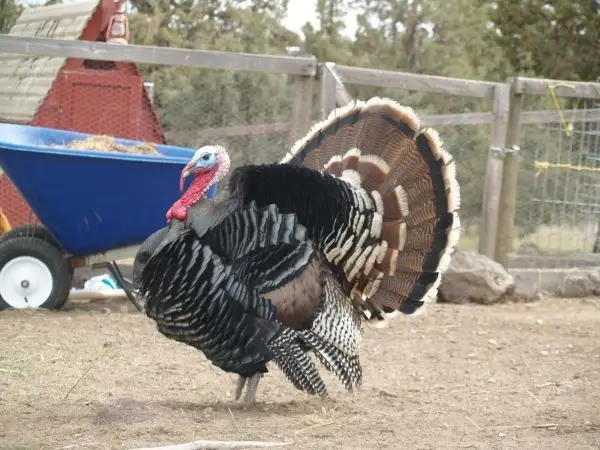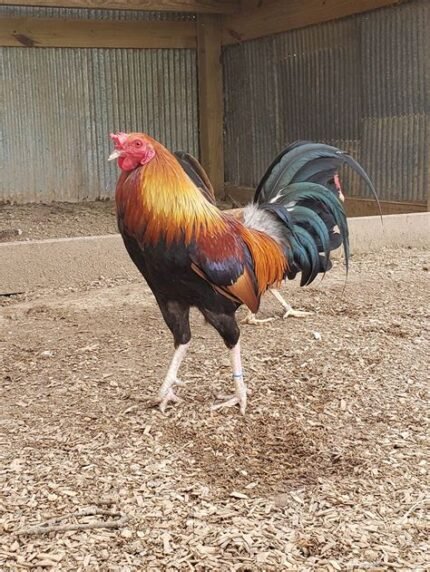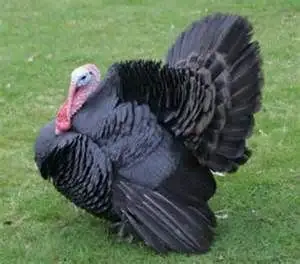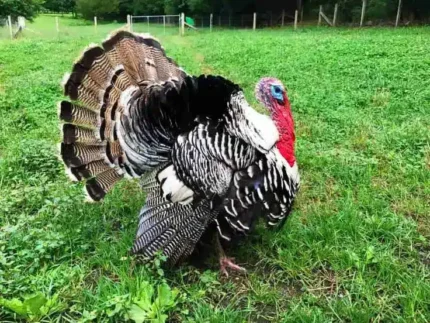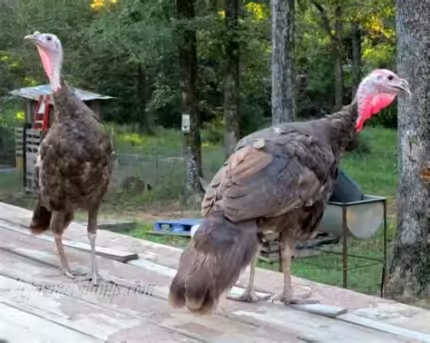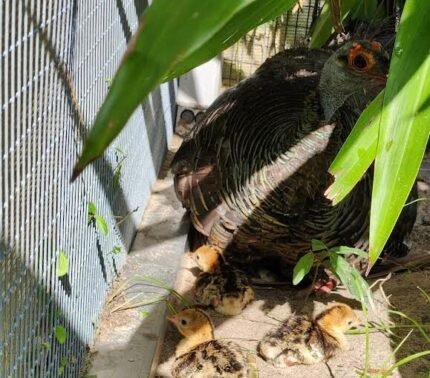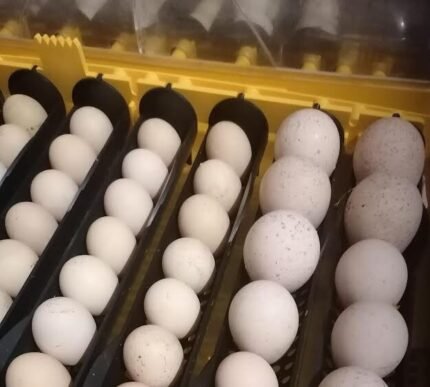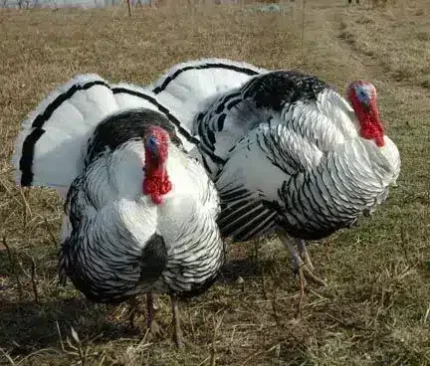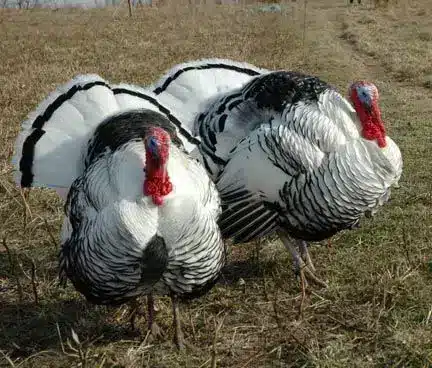
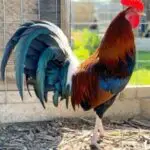
Standard Bronze Turkeys
$20.00 – $200.00Price range: $20.00 through $200.00
Searching for high-quality Standard Bronze Turkeys? At Gamefowls and Turkeys, we offer premium Standard Bronze turkeys known for their striking appearance, rich flavor, and hardiness. These turkeys are perfect for both breeding and consumption, providing exceptional meat quality and a robust disposition. Explore our selection today and bring home the finest Standard Bronze turkeys for your flock!
Standard Bronze Turkeys: A Delightful Choice For Your Feast with Heritage Flavor and Raising Guide
Standard Bronze Turkeys Imagine carving into a turkey whose meat carries the depth of decades-old genetics and the authentic taste of free-range foraging. This guide delivers expert insights on Standard Bronze Turkeys, revealing their heritage charm, raising requirements, and culinary rewards. Many cooks and small-scale farmers settle for industrially raised birds that lack robust flavor and sustainable pedigree, but adopting Standard Bronze Turkeys transforms your table and your stewardship practices. You will learn what defines this heritage breed, how it contrasts with Broad Breasted Bronze turkeys, step-by-step rearing protocols, exceptional cooking methods, reliable sources for stock and meat, conservation initiatives, and how to choose among heritage varieties for your living flock.
What Are Standard Bronze Turkeys? Heritage Bronze Turkey Characteristics Explained
Standard Bronze Turkeys are a heritage turkey breed prized for their lustrous copper and bronze plumage, natural mating ability, and lean, flavorful meat. Recognized by the American Poultry Association in 1874, they bridge domestic selection with wild turkey genetics, resulting in a robust bird adaptable to free-range systems. Their slow growth rate and active foraging behavior yield firmer muscle fibers and intensified flavor, making them a centerpiece for both farm and kitchen. Exploring these defining features prepares us to trace their origin, describe their appearance, and understand their heritage status and conservation needs.
What is the history and origin of Standard Bronze Turkeys?
Standard Bronze Turkeys originated in mid-19th-century North America when domestic turkeys were crossed with Eastern Wild Turkeys to combine hardiness, natural foraging, and striking plumage, achieving official recognition by the American Poultry Association in 1874. This breeding strategy preserved wild traits that support genetic resilience and distinct flavor development, establishing the foundation for what we now call a heritage turkey. For instance, early breeders selected birds exhibiting the metallic sheen and robust constitution that survive pasture-based conditions. Tracing this lineage sets the stage for understanding how their distinctive iridescence and robust performance evolved.
What are the physical characteristics and appearance of Standard Bronze Turkeys?
Standard Bronze Turkeys exhibit a broad breast, upright posture, and a mix of copper, bronze, and metallic green hues across their feathers, with toms showcasing more intense iridescence during breeding displays. Adult toms typically weigh between 25 and 36 pounds, while hens range from 14 to 20 pounds, reflecting sexual dimorphism common among heritage breeds. Their strong legs and deep bodies support active foraging and free-range movement, contributing to firmer meat texture. Appreciating these anatomical traits clarifies why Standard Bronze Turkeys excel in both exhibition and table applications.
| Characteristic | Male Standard Bronze | Female Standard Bronze |
|---|---|---|
| Average Mature Weight | 25–36 lb | 14–20 lb |
| Plumage Sheen | Intense copper-bronze | Subtle metallic luster |
| Growth Duration | 26–28 weeks to market | 24–26 weeks to market |
Why are Standard Bronze Turkeys classified as a heritage breed?
Heritage Turkey status requires three key criteria: natural mating ability, a long productive lifespan, and a slow growth rate that mimics wild counterparts. Standard Bronze Turkeys reproduce without artificial insemination, sustaining self-propagating flocks and preserving genetic diversity. Their extended growth period of around 26–28 weeks allows muscle development and depth of flavor absent in fast-growing commercial lines. Meeting these standards confirms their place among genuine heritage poultry and underpins ongoing conservation efforts.
How does the conservation status impact Standard Bronze Turkeys?
Standard Bronze Turkeys are listed on The Livestock Conservancy’s “Watch” category, indicating a moderate risk level that demands breeder participation to maintain viable populations. This status spurs heritage poultry enthusiasts to prioritize breeding programs, share genetic lines, and promote educational outreach on sustainable poultry husbandry. Conservation designations encourage record-keeping of flock pedigrees and drive demand for certified heritage stock. Recognizing this Watch status highlights the role each homesteader plays in safeguarding a living piece of agricultural heritage.
How Do Standard Bronze Turkeys Differ from Broad Breasted Bronze Turkeys?
Standard Bronze and Broad Breasted Bronze turkeys share superficial color similarities but diverge sharply in growth patterns, breeding methods, and meat quality. Standard Bronze turkeys mature slowly, mate naturally, and forage actively, resulting in leaner muscle fibers and a richer taste profile. In contrast, Broad Breasted Bronze birds are bred for rapid growth and large breast yields, often requiring artificial insemination to sustain high-volume production. Comparing these breeds reveals trade-offs between industrial efficiency and authentic heritage values.
What are the key differences in growth rate and size?
Standard Bronze Turkeys require 26–28 weeks to reach market weight, finishing at 25–36 pounds for toms, while Broad Breasted Bronze turkeys achieve 30–40 pounds in just 18–20 weeks due to intensive selection for rapid muscle gain. The extended maturation period of Standard Bronzes yields finer grain muscle and deeper flavor compounds. Conversely, accelerated growth in Broad Breasted birds prioritizes volume over textural integrity. Distinguishing these timelines underscores the heritage breed’s commitment to quality over quantity.
Bronze Standard Turkeys: Growth Rate and Meat CharacteristicsThe growth rate, such as that of the Bronze Standard, is justified. The flavor precursors are more difficult to release when the meat is…Nutritional value and physicochemical properties of male and female broad-breasted bronze turkey muscle, A Czech, 2024
Research indicates that the growth rate of breeds like the Bronze Standard is a key factor in developing flavor precursors within the meat. This extended development period is crucial for achieving the desired taste profile.
| Breed | Growth Time | Typical Male Weight |
|---|---|---|
| Standard Bronze Turkey | 26–28 weeks | 25–36 lb |
| Broad Breasted Bronze | 18–20 weeks | 30–40 lb |
How do breeding methods differ between Standard Bronze and Broad Breasted turkeys?
Standard Bronze Turkeys rely exclusively on natural mating behaviors, promoting robust fertility rates and self-sustaining flocks. Broad Breasted turkeys, selected for oversized breast muscles, often lose natural breeding ability and require artificial insemination to maintain genetic lines. Choosing heritage stock encourages ecological balance on pasture and reduces dependency on interventionist reproduction techniques. This fundamental difference reflects broader sustainability and animal-welfare considerations.
How does meat flavor and quality compare between the two breeds?
The leisurely development of Standard Bronze Turkeys produces leaner meat with a firm texture and a deep, game-like flavor that retains moisture during roasting. In contrast, rapidly grown Broad Breasted Bronze turkeys yield softer, milder meat prone to dryness under high-heat cooking. Active foraging enhances the heritage bird’s muscle tone and deposits flavor-rich fats, delivering a more satisfying eating experience. Culinary enthusiasts often favor heritage turkey for its robust taste and hearty mouthfeel.
How to Raise Standard Bronze Turkeys: A Complete Guide for Beginners

Raising Standard Bronze Turkeys begins with selecting healthy poults, providing optimal brooding conditions, balanced nutrition, comfortable housing, and facilitating natural breeding. A systematic approach ensures vigorous growth, disease resistance, and exceptional meat quality. Whether starting with day-old poults or hatching your own eggs, attention to detail during each life stage builds a sustainable flock suited to free-range environments.
Where can you buy Standard Bronze turkey poults and hatching eggs?
Certified heritage hatcheries and specialized breeders offer Standard Bronze turkey poults and fertile hatching eggs with documented lineage to guarantee breed authenticity. Look for providers who participate in heritage breed registries and maintain transparent breeding records. Poults typically arrive at one day old, acclimated to brooder conditions, while eggs require precise temperature and humidity control in incubators. Securing stock from reputable sources lays the groundwork for a thriving heritage flock.
What are the best practices for brooding and early care of Standard Bronze poults?
The following steps outline brooding and early care protocols for Standard Bronze poults.
- Maintain brooder temperature at 95 °F during week 1, decreasing by 5 °F each week until 70 °F.
- Provide 24-hour access to fresh water supplemented with electrolytes during the first 72 hours.
- Offer a starter feed containing 28% protein for the first three weeks to support rapid skeletal development.
- Ensure at least two square feet of brooder space per poult and introduce supervised outdoor foraging after two weeks.
Growth Performance of Bronze Heritage TurkeysThis study aimed to compare the growth performance of White, Black, and Bronze turkeys, recently introduced in Bangladesh. The birds were raised under a semi-intensive system at the BAU Poultry Farm, supplemented with commercial broiler grower and layer feeds. The primary objectives were to investigate the growth performance of locally available heritage turkeys under a semi-intensive rearing system and to propose turkey production as a supplementary component of the existing poultry industry in Bangladesh. A total of 46 unsexed poults, aged 5 weeks, comprising White, Black, and Bronze color types, were housed. The birds were managed under identical conditions and fed commercially sourced feed. No statistically significant difference (p>0.05) in live weight was observed among the three color types. At the conclusion of the 21-week rearing period, Bronze turkeys achieved the highest average live body weight (3720.71g/bird), while White turkeys recorded the lowest (3282.29g/bird).Nutritional value and physicochemical properties of male and female broad-breasted bronze turkey muscle, A Czech, 2024
Studies comparing different heritage turkey varieties, including Bronze, have shown that while there may not be significant differences in live weight across all types, the Bronze variety often achieves the highest average body weight by the end of the rearing period.
How should you feed and provide nutrition for optimal growth and health?
Balanced feeding for Standard Bronze Turkeys combines commercial heritage-breed rations with access to pasture and supplemental grains. During the grower phase (4–12 weeks), provide 20% protein feed and allow foraging on grasses, legumes, and insects to enhance muscle texture and flavor. After 12 weeks, transition to a maintenance feed at 16% protein while encouraging free-range exploration to reduce grain costs and amplify meat quality. This nutritional strategy supports consistent growth and robust health.
What housing and free-range management techniques support healthy turkeys?
Creating a secure coop with sturdy roosts, predator-proof fencing, and dry bedding protects Standard Bronze Turkeys from weather extremes and nighttime threats. Allocate two to three square feet of indoor space per bird and four to five square feet of outdoor pasture area to facilitate natural behaviors. Rotational grazing prevents parasite buildup and promotes diverse forage intake. Well-designed housing and pasture systems foster strong birds and enrich their flavor profile.
How to manage natural breeding and flock sustainability?
Maintaining a ratio of one tom to eight hens encourages effective natural mating among Standard Bronze Turkeys and preserves genetic vigor. Select breeding stock based on health, temperament, and confirmed heritage lineage, rotating toms annually to avoid inbreeding. Collect and incubate a limited number of eggs to replenish your flock or share with breeders. Encouraging natural reproductive cycles sustains a self-renewing heritage population.
What are common health issues and disease prevention tips for heritage turkeys?
Standard Bronze Turkeys benefit from routine vaccination against Marek’s disease and monitoring for coccidiosis during the brooding stage. Implement strict biosecurity by sanitizing feeders and waterers, isolating new arrivals for two weeks, and providing ample ventilation to reduce respiratory infections. Rotate pasture and remove wet litter promptly to prevent bacterial proliferation. Proactive health management ensures a resilient flock capable of thriving in pasture-based systems.
Why Choose Standard Bronze Turkey Meat for Your Feast? Flavor, Cooking, and Culinary Benefits
Standard Bronze turkey meat stands out for its robust, nutty flavor and lean, well-structured texture that elevates any roast or braise into a memorable centerpiece. Slow maturation and active foraging develop complex flavor compounds and firmer muscle fibers. Known for moist results even under high-heat roasting, heritage turkey turns holiday traditions into gourmet experiences.
What makes the flavor of Standard Bronze turkey meat unique and superior?
Standard Bronze meat gains depth from prolonged muscle development and diverse foraging on greens, seeds, and insects, which deposit rich amino acids and healthy fats into the muscle tissue. This heritage breed’s lean profile yields a concentrated turkey essence and satisfying chew that stands up to bold seasonings. Every bite reflects slow-growth craftsmanship, rewarding roasters and chefs with consistency and exceptional taste.
How does Standard Bronze turkey meat compare to commercial turkey meat?
Heritage turkey delivers firmer texture, deeper color, and pronounced turkey flavor, while commercial Broad Breasted White turkey often presents pale, milder meat prone to dryness. Standard Bronze’s balanced fat distribution retains moisture during roasting, preventing the stringy texture common in industrial birds. Consumers appreciate the difference in mouthfeel and flavor intensity, making heritage turkey a coveted choice for special occasions.
What are the best recipes and cooking methods for Standard Bronze turkeys?
The following table highlights popular cooking techniques that showcase heritage turkey flavor.
| Recipe | Technique | Flavor Highlight |
|---|---|---|
| Classic Herb-Butter Roast | High-heat sear, then oven | Crisp skin, savory herbs |
| Dry-Brine and Spatchcock Roast | Twenty-four-hour brine, roast | Juicy breast, even cooking |
| Slow-Cook Turkey Ragu | Braise in tomato sauce | Tender meat, rich sauce |
How to prepare and cook a Standard Bronze turkey for a holiday feast?
Begin by dry-brining the bird with kosher salt, herbs, and aromatics for at least 24 hours to enhance seasoning penetration. Preheat the oven to 425 °F, roast the turkey breast-side down for the first 30 minutes, then reduce to 325 °F and rotate after an hour to ensure even cooking. Baste sparingly every 45 minutes and remove when an instant-read thermometer registers 165 °F in the thickest thigh. Rest the turkey for 20 minutes before carving to allow juices to redistribute for peak tenderness.
Why is choosing heritage turkey meat an ethical and sustainable choice?
Heritage breeds like Standard Bronze support biodiversity by preserving genetic lines lost in industrial flocks. Natural mating, pasture foraging, and smaller flock sizes reduce reliance on confinement and artificial reproduction methods. Consumers who select heritage turkey foster animal-welfare standards and contribute to regenerative agriculture practices. Embracing heritage meat embodies a commitment to ecological stewardship and culinary excellence.
Where to Buy Standard Bronze Turkeys and Poults: Trusted Sources and Availability
You can source Standard Bronze poults, hatching eggs, and processed heritage turkey meat from dedicated hatcheries, local farms, and specialty markets that uphold breed standards and ethical practices. Choosing verified suppliers ensures authenticity and healthy stock for your flock or table.
Which hatcheries and farms specialize in Standard Bronze turkey poults?
Reputable heritage breeders maintain membership in poultry associations and adhere to pedigree tracking for true Standard Bronze stock. Look for hatcheries offering health guarantees, early-life vaccination options, and shipping protocols that minimize stress on day-old poults. Farms with on-site tours and transparent breeding archives provide added assurance of lineage. Selecting these specialists lays the groundwork for a thriving heritage operation.
How to verify the quality and heritage status when purchasing?
Request breed certificates or pedigrees that confirm American Poultry Association recognition and The Livestock Conservancy registration. Examine live birds for characteristic copper-bronze plumage, upright carriage, and active foraging behavior. Inquire about health records, vaccination history, and early-life care practices. Verified heritage status protects genetic integrity and ensures the conservation mission of your Standard Bronze flock.
What are the options for buying Standard Bronze turkey meat?
Local farms and artisanal butchers may offer whole heritage turkeys, frozen halves, or custom cuts, often processed according to small-batch quality standards. Specialty food markets and online farm-to-table purveyors facilitate home delivery of vacuum-sealed Standard Bronze breast, legs, or ground meat. Purchasing directly from producers supports small-scale agriculture and guarantees traceability from pasture to plate.
What Are the Conservation Efforts and Community Resources for Standard Bronze Turkeys?
Conservation organizations, breeder associations, and enthusiast networks collaborate to promote Standard Bronze Turkey preservation through educational outreach, breeding programs, and heritage celebrations. Collective efforts amplify awareness and encourage sustainable flock stewardship.
How does The Livestock Conservancy support Standard Bronze turkey preservation?
The Livestock Conservancy’s Watch listing for Standard Bronze Turkeys mobilizes breeders with grant incentives, genetic diversity tracking, and heritage breed summits. Educational materials and breeder directories connect new stewards with experienced mentors. Ongoing research into population trends informs conservation priorities and encourages small-scale propagation. This coordinated approach safeguards a heritage lineage essential to agricultural resilience.
How can homesteaders and farmers contribute to heritage turkey conservation?
By maintaining open-pollinated flocks, sharing breeding stock with fellow keepers, and recording pedigree data, homesteaders bolster genetic diversity. Organizing local heritage poultry fairs and participating in breed exchanges spreads awareness of heritage turkey value. Integrating Standard Bronze Turkeys into diversified farm enterprises demonstrates their adaptability and conservation benefit in regenerative agriculture systems.
What forums, associations, and communities support Standard Bronze turkey enthusiasts?
Online heritage poultry groups, regional poultry clubs, and national breed associations host discussions on breeding techniques, health protocols, and culinary experiments. Social media communities share brood-to-table stories, while local extension programs offer practical workshops on incubation, disease prevention, and coop design. Engagement with these networks enriches knowledge and fosters a collective commitment to heritage preservation.
What are frequently asked questions about Standard Bronze turkeys?
Enthusiasts often wonder about ideal brooding temperatures, incubation hatch rates, feed conversion ratios, and seasonal availability of hatching eggs. Questions also focus on heritage certification requirements and best practices for integrating poults into mixed-species pastures. Clarifying these concerns empowers new keepers to plan flocks, manage nutrition, and ensure healthy breeding cycles.
How to Compare Standard Bronze Turkeys with Other Heritage Breeds?
Evaluating Standard Bronze Turkeys alongside Bourbon Red, Narragansett, and other heritage varieties highlights differences in appearance, growth patterns, and flavor, guiding informed breed selection based on goals and environment. Side-by-side comparisons clarify which traits best suit exhibition, meat production, or mixed-farm use.
What are the differences between Standard Bronze and Bourbon Red turkeys?
Standard Bronze Turkeys boast iridescent bronze plumage and a slow 26–28-week growth cycle, while Bourbon Reds present deep mahogany feathers and a slightly faster 24–26-week maturation. The heritage bronze breed offers a more pronounced wild-turkey flavor, whereas Bourbon Reds tend toward a milder, buttery taste favored in braising dishes. Size and temperament differences also influence handling ease and display appeal.
How do Standard Bronze turkeys compare to Narragansett and other heritage breeds?
Narragansett Turkeys display slate gray and black plumage with a calm disposition suitable for mixed-species flocks, maturing in 25–27 weeks at 20–30 pounds. In contrast, Standard Bronze requires more pasture space but delivers bolder flavor and larger frame size. Other heritage breeds vary in egg production, cold-hardiness, and foraging intensity, making Standard Bronze an ideal choice for flavor-driven backyard or small-farm operations.
Growth Performance of Heritage Turkey Varieties: White, Black, and BronzeThis study evaluated the growth performance of White, Black, and Bronze heritage turkey varieties recently introduced in Bangladesh. The birds were raised in a semi-intensive system at the BAU Poultry Farm, supplemented with commercial broiler grower and layer feeds. The primary objectives were to investigate the growth performance of these locally available heritage turkeys under a semi-intensive rearing system and to propose turkey as a supplementary component to existing poultry businesses in Bangladesh. A total of 46 unsexed poults, aged 5 weeks, comprising White, Black, and Bronze color types, were housed. The birds were managed under identical conditions, and feed was sourced from the local market. No statistically significant difference (p>0.05) in live weight was observed among the three color types. At the conclusion of the 21-week rearing period, Bronze turkeys achieved the highest average live body weight (3720.71 g/bird), while White turkeys recorded the lowest (3282.29 g/bird).Growth performance of white, black and bronze color heritage turkeys under semi-intensive system: Growth performance of heritage turkeys, SC Das, 2018
Research conducted in Bangladesh comparing White, Black, and Bronze heritage turkey varieties under a semi-intensive system found that while live weights were not statistically different across the types, the Bronze variety consistently achieved the highest average body weight by the end of the 21-week rearing period.
What factors should influence your choice of heritage turkey breed?
Purpose—meat quality, exhibition, or egg production—drives breed selection, as does available pasture space, climate tolerance, and desired growth timeline. Consider adult weight, temperament around children or other livestock, and conservation priority status. Flavor preference and processing capacity also shape the best breed match for your homestead. Balancing these criteria ensures a satisfying heritage turkey experience.
Standard Bronze Turkeys combine historic pedigree, sustainable breeding, and unparalleled flavor to transform homesteads and holiday feasts alike. Their natural mating capacity, slow growth curve, and iridescent plumage reflect a living legacy worth preserving on any farm. Following this comprehensive guide equips you to raise, prepare, and celebrate heritage turkeys with confidence and culinary flair. Embracing Standard Bronze Turkeys supports conservation efforts and elevates every gathering into a true heritage feast.
| Quantity |
Male ,Female ,Chick |
|---|
